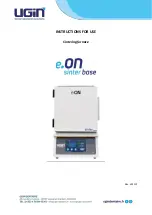
6
Unitary Products Group
In order for the burner flame to burn
efficiently, it must receive adequate
combustion air.
The amount of combustion air can be
changed by operatingthe combustion
air adjustment rod located beneath
the gas valve. See Figure 2.
The adjustment rod is set at an “aver-
age” position at the factory and may
be properly set for many applications.
However, the amount of combustion
air required will vary depending on al-
titude, actual BTU. content of the gas
being used, gas pressure, conversion
to another gas, and other variable fac-
tors.
Therefore, it is essential that the burn-
er flame be observed and any neces-
sary adjustments are made before
the furnace is put into service at the fi-
nal home site. Adjustingthe burner air
is considered part of the normal home
set--up procedure and is the responsi-
bility of either the home seller or buy-
er, depending on their agreement.
Adjustments of this type are not cov-
ered by the warranty.
Combustion air adjustments
must be made only by a quali
Ć
fied technician. Improper air
adjustment may cause un
Ć
safe operation, explosion or
asphyxiation.
To adjust the combustion air:
1. To light and operate furnace see
label inside lower furnace door.
2. Allow the burner to burn for about
1 MINUTE.
3. Look through the observation
window and observe the appear-
ance of the flame.
4. On natural gas, the base of the
flame should be blue but the tips
of the flame will be yellow. See
Figure 6.
5. On Propane gas, almost all of the
flame will be yellow although
some blue should still be present
at the base of the flame next to
the end of the burner. See Figure
7.
6. If the flame is too yellow, the com-
bustion air should be increased. If
the flame is excessively blue (no
yellow) the combustion air should
be decreased.
7. To adjust the combustion air,
loosen the lock screw holding the
combustion air rod in place. Push
in on the rod to increase the com-
bustion air. Pull out on the com-
bustion air rod to decrease the
combustion air. Tighten lock
screw after adjustment is made.
View of Burner Through the Observation Window
LIGHT BLUE
WITH YELLOW TIPS
DARK BLUE
BLUE TIPS JUST STARTING
TO BECOME PRONOUNCED.
YELLOW WITH
ORANGE TIPS
LIGHT BLUE
NO BLUE TIPS
EXTENDING
FROM THE END
OF THE BURNER
DARK BLUE
DARK BLUE
LONG AND EXTREMELY
PRONOUNCED BLUE TIPS
EXTENDING FROM THE
END OF THE BURNER
WHTISH YELLOW TO
LIGHT YELLOW
LIGHT BLUE
BLUE TIPS JUST STARTING
TO BECOME PRONOUNCED
DARK YELLOW TO
ORANGISH YELLOW
MAIN FLAME IS A
WHITISH YELLOW
REFLECTIVE COL-
OR.
VERY LITTLE BLUE
EXTENDING FROM
THE END OF THE
BURNER.
WHITISH YELLOW
LIGHT BLUE
LONG AND EXTREMELY
PRONOUNCED BLUE TIPS
EXTENDING FROM THE
END OF THE BURNER
CORRECT AMOUNT OF
PRIMARY AIR
TOO LITTLE PRIMARY AIR
PUSH SHUTTER ROD IN
TOO MUCH PRIMARY AIR
PULL SHUTTER ROD OUT
CORRECT AMOUNT OF
PRIMARY AIR
TOO LITTLE PRIMARY AIR
PUSH SHUTTER ROD IN
TOO MUCH PRIMARY AIR
PULL SHUTTER ROD OUT
FIGURE 7 -- PROPANE GAS FLAME APPEARANCE
FIGURE 6 -- NATURAL GAS FLAME APPEARANCE


























